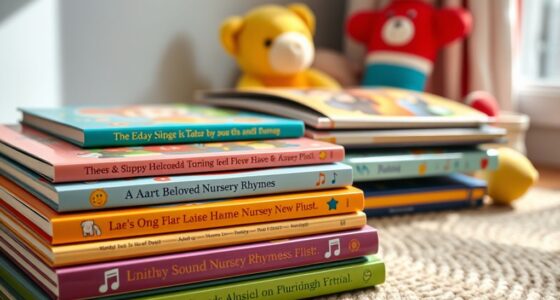If you’re looking for the best emotion books for toddlers, I recommend titles like “A Little SPOT of Emotion” plush set, “My First Book of Emotions,” and “The Rabbit Listened,” which help little ones recognize and talk about feelings through bright pictures and engaging stories. Books such as “Calm-Down Time” and “Hands Are Not for Hitting” support emotional regulation and positive behavior. Keep exploring to discover more tools that make learning about feelings fun and effective.
Key Takeaways
- These books feature vibrant illustrations and simple language to introduce toddlers to a wide range of feelings and emotional vocabulary.
- Many include interactive elements like mirrors, textures, and flaps to engage children and promote emotional understanding.
- They address core emotions such as happiness, sadness, anger, and fear, helping children recognize and communicate their feelings.
- The recommended titles emphasize inclusivity, diversity, and relatable characters to foster empathy and emotional resilience.
- Durable, engaging designs ensure longevity for frequent use in home, classroom, or therapy settings.
A Little SPOT of Emotion 8 Plush Toys with Feelings Book Box Set
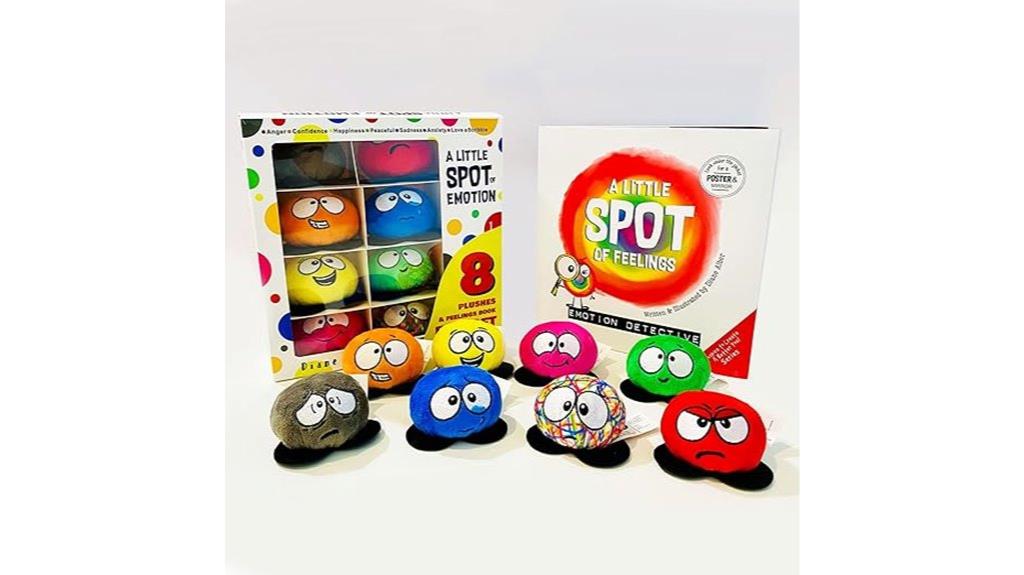
The A Little SPOT of Emotion 8 Plush Toys with Feelings Book Box Set is an excellent choice for children, therapists, and parents looking to build emotional awareness through hands-on play. I love how it includes eight plush toys, each representing a different emotion like anger, sadness, or happiness, along with a beautifully illustrated hardcover book. The set also has a feelings poster and a mirror to help kids recognize facial expressions. The plush toys are soft, engaging, and perfect for small hands, making it easy for children to connect with their feelings. It’s a practical, fun tool that makes understanding emotions tangible and accessible.
Best For: children, therapists, and parents seeking a tactile and engaging way to develop emotional awareness and regulation skills.
Pros:
- Includes eight plush toys representing a variety of emotions, making feelings tangible and relatable
- Comes with a beautifully illustrated hardcover book, feelings poster, and mirror to enhance emotional recognition
- Suitable for both individual and group therapy, classroom, and home use, promoting emotional understanding through play
Cons:
- Some users may confuse the plush toy set with multiple books, leading to potential misunderstandings about the product contents
- Plush faces should be treated as emotional references rather than just toys to avoid trivializing feelings
- The set’s primary focus is on children, so adult use may require additional context or explanation
My First Book of Emotions for Toddlers
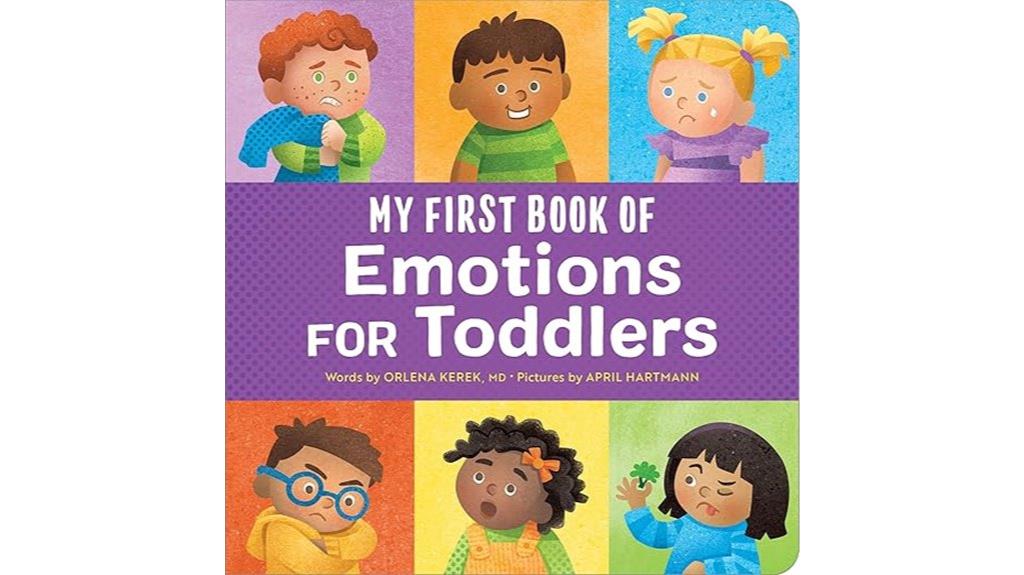
If you’re looking for an engaging way to introduce your toddler to their feelings, “My First Book of Emotions for Toddlers” is an excellent choice. It teaches six common emotions—fear, anger, joy, sadness, disgust, and surprise—using simple language, colorful illustrations, and relatable examples. The big, vibrant pictures make it easy for little ones to recognize facial expressions and body language, fostering their understanding of emotions. Designed for small hands, the sturdy board book is perfect for frequent use and bedtime stories. Many parents find it helpful for building emotional vocabulary and encouraging open discussions about feelings, making it a valuable early learning tool.
Best For: parents, caregivers, and educators seeking a fun, accessible way to teach toddlers about their emotions and build emotional awareness.
Pros:
- Engaging, colorful illustrations that capture young children’s attention and aid in emotion recognition.
- Durable board book design perfect for small hands and frequent use.
- Simple, age-appropriate language that encourages discussion and emotional vocabulary development.
Cons:
- May be too long or repetitive for very young toddlers, which could lead to loss of interest.
- Some children might need shorter, more focused sessions to stay engaged.
- Limited to six emotions, which may not cover the full spectrum of feelings children experience.
My First Book of Emotions for Toddlers
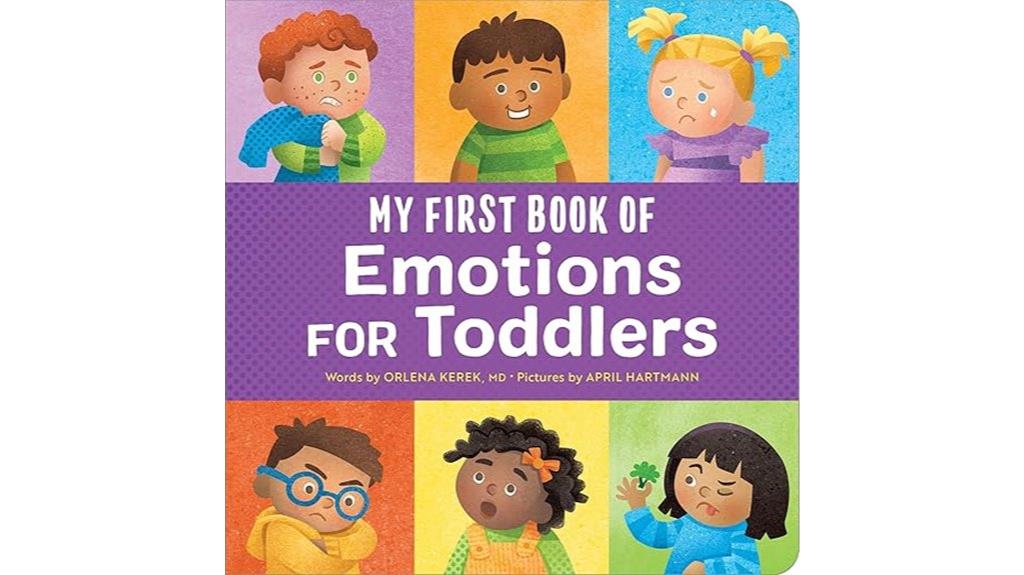
My First Book of Emotions for Toddlers is an excellent choice for parents and caregivers looking to introduce young children to their feelings in a simple, engaging way. It teaches six core emotions—fear, anger, joy, sadness, disgust, and surprise—using age-appropriate language, colorful illustrations, and relatable examples. The vibrant images of kid characters help toddlers recognize facial expressions and body language, making emotional understanding fun and visual. Designed as a durable board book, it’s perfect for small hands and frequent use. This book encourages conversations about feelings, fostering self-awareness and empathy, making it a valuable tool for early emotional development.
Best For: parents, caregivers, and early childhood educators seeking an engaging, durable tool to introduce toddlers to basic emotions and promote emotional literacy.
Pros:
- Bright, colorful illustrations that capture young children’s attention and make recognizing emotions fun.
- Simple, age-appropriate language that aids in developing emotional vocabulary and understanding.
- Durable board book design perfect for frequent handling by small hands.
Cons:
- Some toddlers may find the length or repetitive content too much, leading to decreased interest.
- The focus on only six emotions may limit broader emotional understanding as children grow.
- Might require short reading sessions to maintain engagement, especially with very young children.
The Rabbit Listened

Looking for a gentle story that teaches toddlers the power of empathy and patience? “The Rabbit Listened” by Cori Doerrfeld is an ideal choice for young children who are just beginning to understand and express their emotions. This heartfelt book highlights the importance of simply being there for someone in distress. When Taylor faces sadness, various animals try to help in different ways, but it’s the rabbit—who listens quietly—that brings comfort. Its simple, profound message about emotional support, empathy, and kindness resonates with kids and adults alike. It’s a perfect story to introduce the idea that sometimes, listening is the best way to help.
Best For: parents, teachers, and caregivers seeking a gentle, impactful story to teach young children about empathy, patience, and emotional support.
Pros:
- Simple, accessible language perfect for toddlers and young children
- Beautiful illustrations that complement and enhance the emotional message
- Widely recommended by mental health professionals and educators for fostering empathy and emotional regulation
Cons:
- May be too simplistic for older children seeking more complex discussions about emotions
- Some readers might find the story too minimalistic or understated in plot development
- Limited diversity in characters or scenarios, which could be a consideration for inclusive storytelling
Calm-Down Time (Toddler Tools® Board Books)
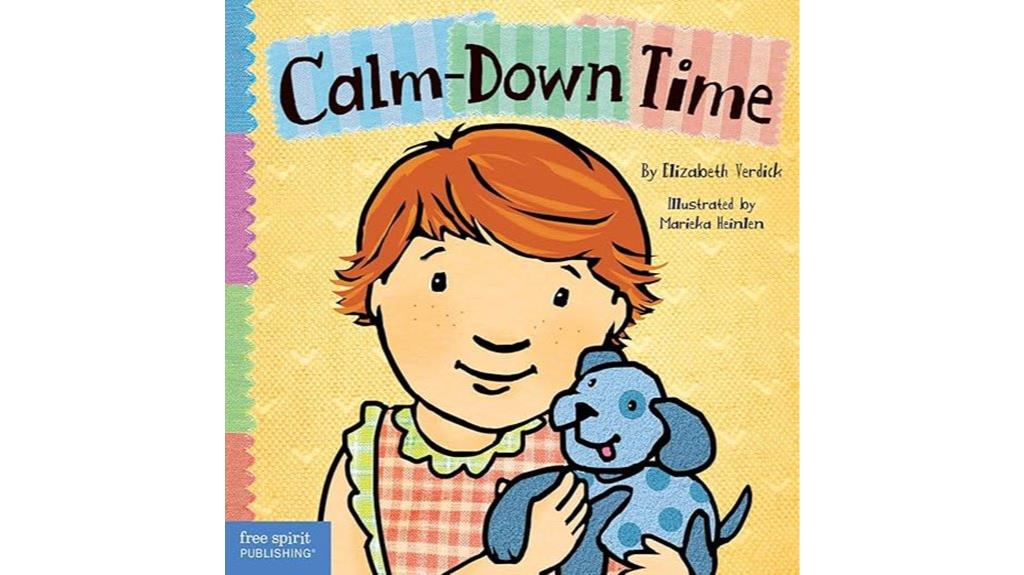
Parents, teachers, and caregivers seeking an effective tool to help toddlers manage big feelings will find Calm-Down Time (Toddler Tools® Board Books) especially valuable. This book teaches children self-calming techniques like deep breathing, recognizing emotions, and creating calm-down spaces. It’s praised for its ability to consistently soothe kids during meltdowns and tantrums. The simple words, warm visuals, and interactive exercises make learning engaging and practical. Many parents and educators report that children not only calm down faster but also develop better emotional awareness. It’s a versatile resource, suitable for kids from 18 months to 4 years, including those with attention or developmental challenges.
Best For: parents, teachers, and caregivers seeking an engaging and effective tool to help toddlers aged 18 months to 4 years manage big feelings and develop self-calming skills.
Pros:
- Teaches practical calming techniques like deep breathing and creating calm-down spaces
- Uses simple language and warm visuals that are engaging and easy for toddlers to understand
- Highly effective in soothing children during meltdowns and promoting emotional awareness
Cons:
- Some reviewers note inconsistency in rhyme and rhythm, making reading aloud slightly awkward
- The rhythmic style can vary, which may affect the flow for some readers
- As a board book, it may be limited in length and depth for older or more advanced children
The Color Monster: A Story About Emotions (The Color Monster, 1)
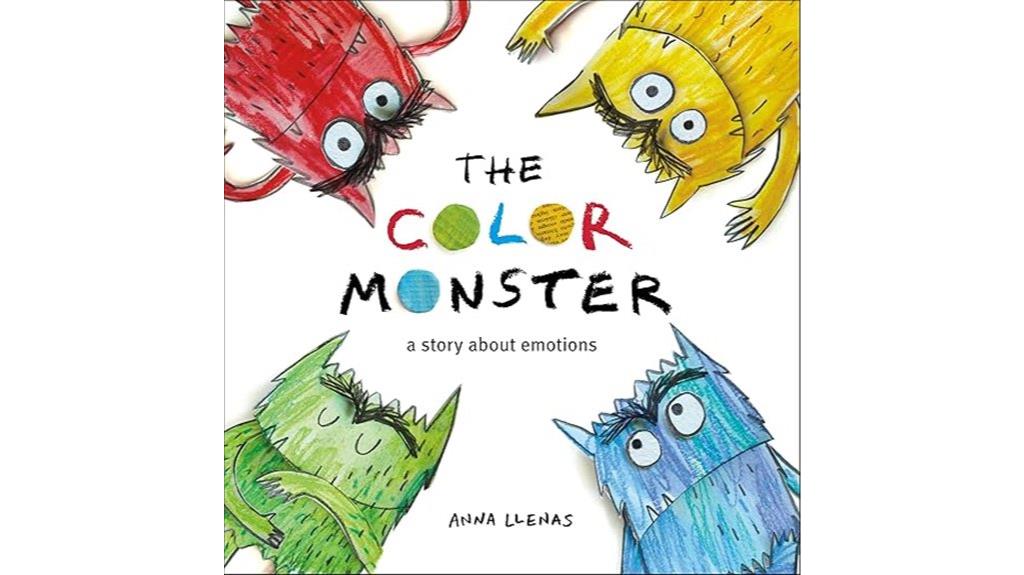
The Color Monster: A Story About Emotions is an excellent choice for caregivers and educators seeking to help young children understand and manage their feelings. I love how this bestselling book uses color to teach kids about emotions like anger, happiness, sadness, and fear. When the Color Monster wakes up confused, a little girl helps him sort his feelings by explaining what each color represents. This process encourages self-awareness and emotional regulation in children. It’s perfect for sparking conversations about feelings and can inspire fun art activities that connect colors with emotions. Overall, it’s a gentle, visual tool for building emotional literacy in toddlers.
Best For: caregivers, educators, and parents seeking to help young children understand and regulate their emotions through visual and interactive methods.
Pros:
- Uses engaging colors to effectively teach children about different emotions.
- Encourages self-awareness and emotional regulation in a gentle, accessible way.
- Serves as a versatile tool for conversations, art activities, and emotional literacy development.
Cons:
- May require adult guidance to fully facilitate emotional discussions.
- The focus on colors might be less effective for children with color vision deficiencies.
- Some children may need additional resources for deeper emotional understanding beyond the book.
Thought-Spot Emotions Chart for Kids Autism Learning Materials

The Thought-Spot Emotions Chart stands out as an ideal tool for children with autism or other special needs because it uses a clear, visual approach to help them identify and communicate their feelings. I find it highly effective because it features large, laminated pages with easy-to-navigate emotion tabs for 20 moods, making it simple for kids to find and express what they’re experiencing. Designed for durability and ease of use, it includes visual cues like emojis and labels that support emotional recognition and regulation. This tool promotes social skills, self-awareness, and coping strategies, empowering children to better understand and manage their emotions independently.
Best For: children with autism or special needs who benefit from visual, structured tools to identify and communicate their emotions independently.
Pros:
- Highly effective visual design with large, laminated pages and clear emotion tabs for easy navigation.
- Supports emotional recognition, regulation, and social skills development through visual cues and simple coping strategies.
- Durable construction with protective hardcover and sturdy pages suitable for frequent use at home, school, or calm-down areas.
Cons:
- Some descriptors for emotions may require additional explanation or instruction (e.g., “bad tempered” for grumpy).
- Tabs and pages may tear or crumple over time due to non-laminated construction, affecting durability.
- Limited variety in coping strategies and action options, which may reduce engagement or adaptability for some children.
The Emotions Book: A Little Story About Big Emotions (Brave Kids Press)
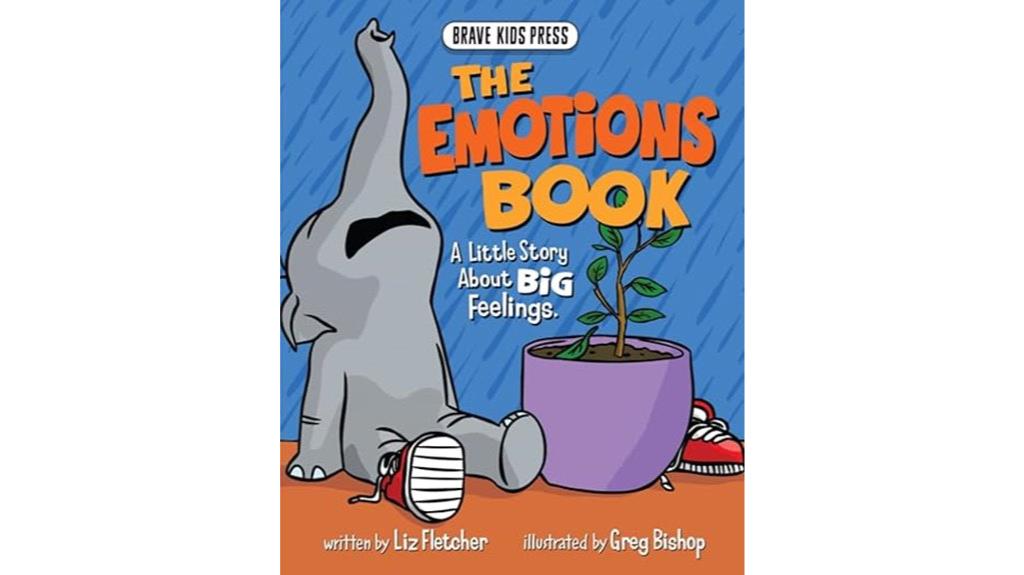
If you’re looking for a gentle, age-appropriate way to introduce toddlers to big feelings, The Emotions Book: A Little Story About Big Emotions from Brave Kids Press is an excellent choice. This book is part of a series that helps children develop emotional intelligence, focusing on core feelings like anger, sadness, frustration, and happiness. It teaches kids to recognize their emotions, use calming techniques like breathing, and find bravery in difficult moments. With engaging stories and practical strategies, it encourages kids to manage their feelings, build resilience, and see challenges as opportunities for growth—all while fostering kindness and curiosity.
Best For: parents, educators, and caregivers seeking a gentle, age-appropriate tool to help toddlers understand and manage big emotions like anger, sadness, frustration, and happiness.
Pros:
- Engages children with relatable stories and practical calming strategies.
- Promotes emotional intelligence, resilience, and kindness.
- Supports development of self-regulation skills through simple techniques like breathing and taking breaks.
Cons:
- May be too basic for older children or those already familiar with emotional concepts.
- Depends on adult guidance to fully implement strategies and discussions.
- Limited focus on emotions beyond the core four, which might not cover all children’s experiences.
Grumpy Monkey
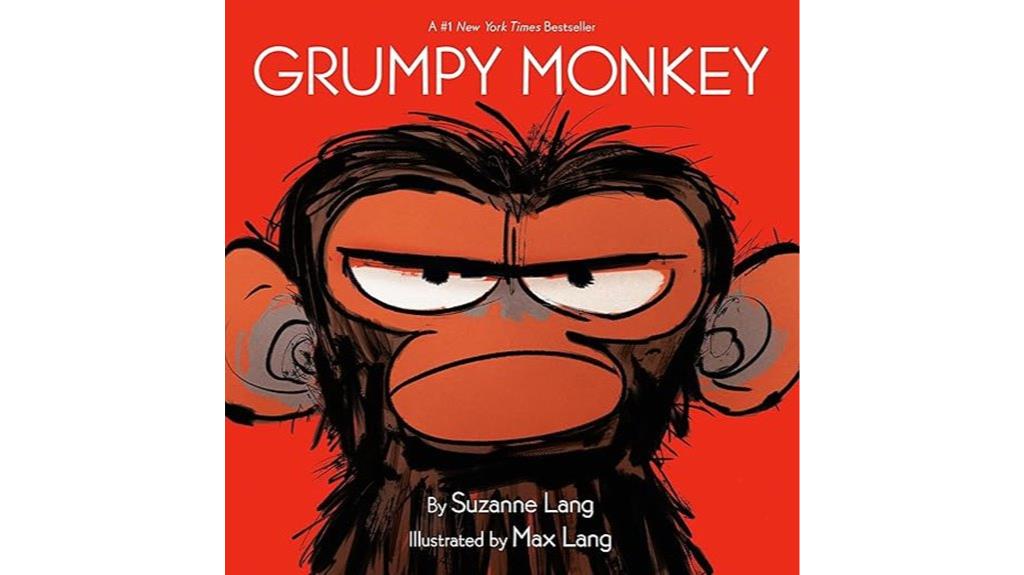
Looking for a book that helps toddlers understand and accept their changing emotions? “Grumpy Monkey” by Suzanne Lang is an excellent choice for young children who need to see that feeling grumpy or upset is completely normal. The story follows Jim, a chimpanzee who wakes up feeling grumpy without knowing why. Through colorful illustrations and humorous moments, the book shows that negative feelings are part of life and shouldn’t be suppressed. It encourages kids to accept their moods, talk about their feelings, and understand that sometimes, it’s okay not to be happy. This gentle message helps children build emotional awareness and self-acceptance.
Best For: young children and their caregivers seeking to understand and accept feelings of grumpiness and emotional ups and downs.
Pros:
- Engaging, colorful illustrations that appeal to young children.
- Promotes emotional literacy and healthy discussions about feelings.
- Relatable message that normalizes negative emotions and encourages self-acceptance.
Cons:
- Cover may show signs of wear over time with frequent use.
- Some children might need additional guidance to fully grasp the emotional concepts.
- As a picture book, it may require adult explanation for deeper emotional understanding.
No Hitting Book for Toddlers
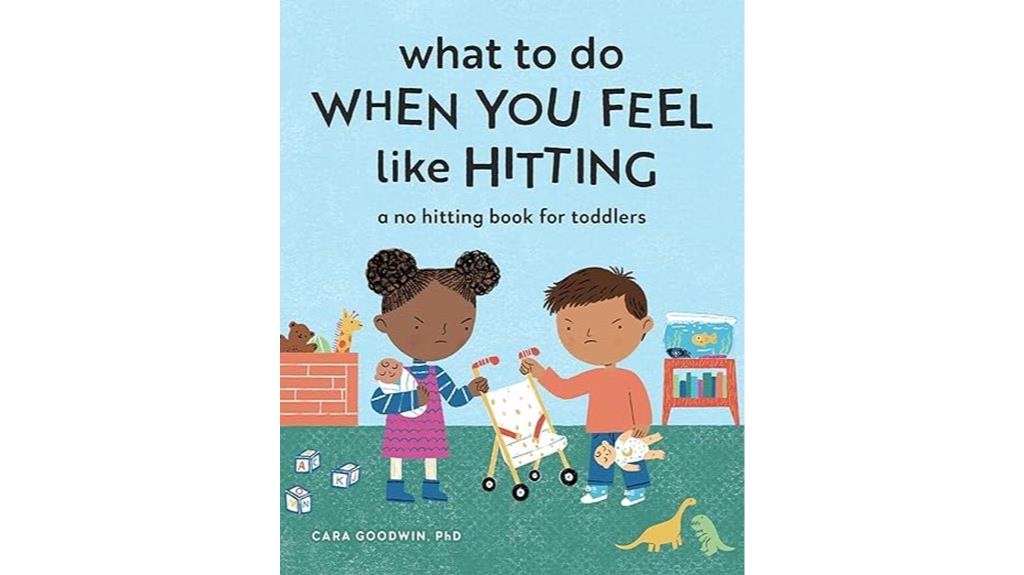
Parents seeking an effective way to teach their toddlers about managing big feelings will find No Hitting Book for Toddlers especially helpful. This engaging book, written by a child psychologist, uses colorful illustrations and simple language to show kids safe ways to handle anger and frustration. Its repetitive structure reinforces coping techniques like squeezing fists, drawing, or taking deep breaths. Many parents notice positive changes, such as reduced hitting and tantrums, after consistent reading. The book also promotes empathy by depicting diverse children and teaches children how to express emotions safely. It’s a practical, kid-friendly resource that helps little ones understand and regulate their feelings.
Best For: parents, caregivers, and educators seeking an effective, engaging tool to teach toddlers emotional regulation and non-violent conflict resolution.
Pros:
- Uses colorful illustrations and simple, repetitive language to reinforce coping strategies effectively.
- Promotes empathy and inclusivity by depicting diverse children and understanding different needs.
- Has received positive feedback for reducing hitting and tantrums when used consistently.
Cons:
- May require adult guidance to maximize understanding and application of techniques.
- Some children might need additional support for speech delays or specific behavioral challenges.
- The effectiveness depends on regular reading and reinforcement, which might be challenging for busy caregivers.
The Color Monster: A Pop-Up Book of Feelings
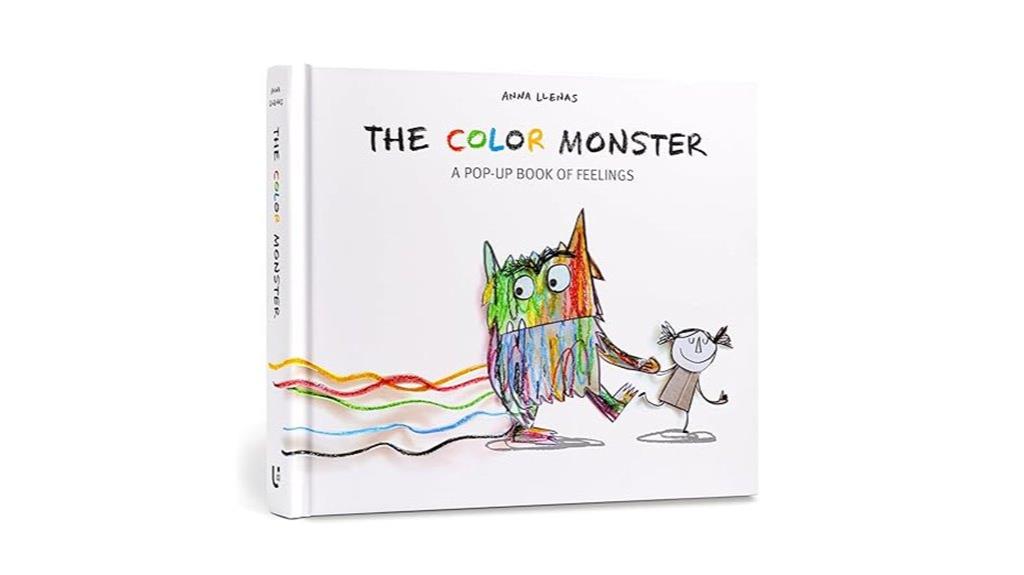
The Color Monster: A Pop-Up Book of Feelings stands out as an ideal choice for young children aged 2 to 4 who are just beginning to explore and express their emotions. Its vibrant illustrations and engaging 3-D pop-ups make learning about feelings fun and memorable. The simple story encourages kids to identify emotions like happiness, sadness, anger, and calm, helping them understand and communicate their own feelings. Parents and educators find it useful for soothing after meltdowns or rough days. Durable and visually appealing, this book fosters emotional awareness while also teaching colors and shapes, making it a versatile, beloved tool for early emotional development.
Best For: young children aged 2 to 4 who are beginning to explore and express their emotions and need a fun, engaging way to understand feelings.
Pros:
- Vibrant illustrations and stunning 3-D pop-ups make the reading experience captivating and interactive.
- Helps children identify and communicate emotions like happiness, sadness, anger, and calm, fostering emotional awareness.
- Durable construction suitable for toddlers, with a versatile educational focus on colors, shapes, and feelings.
Cons:
- Small children should be supervised to prevent tearing or removing pop-up pieces, especially those with string attachments.
- The book’s simple story may require additional discussion for more complex emotional understanding.
- Some children may quickly outgrow the basic concepts if they are already familiar with emotional vocabulary.
Train Your Dragon To Accept NO: Children’s Story About Disagreement and Emotions
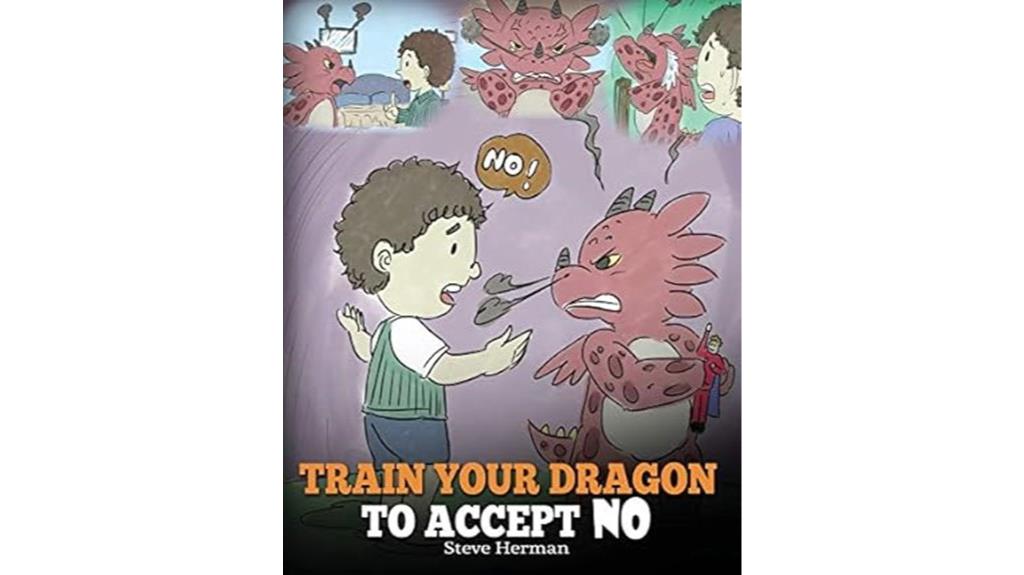
Train Your Dragon To Accept NO is an ideal choice for families seeking engaging stories that teach young children about managing emotions and handling disagreements. This charming book follows a pet dragon as he learns to cope with anger and frustration when told “No.” Through colorful illustrations and fun storytelling, children discover healthy ways to respond to rejection and express their feelings calmly. The story emphasizes the importance of patience and understanding, helping kids navigate conflicts constructively. It’s a valuable resource for parents aiming to teach emotional regulation, making it a must-have for fostering patience and emotional growth in young children.
Best For: parents, teachers, and caregivers seeking engaging, educational stories to teach young children about emotional regulation, patience, and handling rejection.
Pros:
- Colorful illustrations and entertaining storytelling capture children’s attention effectively
- Teaches valuable life skills like anger management and conflict resolution in a relatable way
- Suitable for a wide age range, making it adaptable for different developmental levels
Cons:
- May require adult guidance to fully discuss emotional concepts with very young children
- The theme of a dragon burning down a house could be intense for some sensitive readers
- As a story, it might need supplementary activities to reinforce lessons learned
In My Heart: A Book of Feelings (Growing Hearts)

In My Heart: A Book of Feelings stands out as an ideal choice for young children, especially toddlers just beginning to understand and express their emotions. This bestselling, colorful, interactive book by Jo Witek features whimsical illustrations and a die-cut heart that extends through each page, engaging little readers. It explores a wide range of feelings—happiness, sadness, anger, shyness—in a simple, lyrical way that helps kids recognize and name their emotions. The playful design and relatable content make it perfect for storytime, bedtime, or emotional learning. It’s a wonderful tool to foster emotional awareness and acceptance in young children.
Best For: young children, especially toddlers, who are beginning to recognize and express their emotions through engaging stories and illustrations.
Pros:
- Bright, colorful illustrations and whimsical design capture children’s attention effectively.
- Interactive and simple language helps young children identify and articulate a wide range of feelings.
- Suitable for storytime, bedtime, and emotional development activities, making it versatile for different settings.
Cons:
- May be too basic for older children who need more complex discussions about emotions.
- The interactive elements might wear out or get damaged with frequent use.
- Some children might require additional guidance to fully understand and discuss the feelings presented.
Hands Are Not for Hitting (Board Book) (Best Behavior Series)
https://m.media-amazon.com/images/I/71P4rqCuVML._SY522_.jpg
Looking for a gentle way to teach your toddler about appropriate hand use? “Hands Are Not for Hitting” from the Best Behavior series is an excellent choice for parents, teachers, and caregivers who want to address aggressive behaviors with simple, positive messages. This colorful board book emphasizes what hands are for—helping, hugging, playing—while gently discouraging hitting and swatting. Using engaging questions like “What are hands for?” it encourages children to reflect on their actions. Many caregivers find it especially useful during challenging phases, helping kids understand kindness and self-control through relatable illustrations and reinforcing words. It’s a practical tool to promote peaceful, loving interactions.
Best For: parents, teachers, and caregivers seeking an engaging and gentle way to teach young children about appropriate hand use and reduce aggressive behaviors.
Pros:
- Uses simple, positive messages suitable for children ages 1-4.
- Engaging, colorful illustrations that capture children’s attention and promote understanding.
- Promotes peaceful interactions and provides a helpful tool during challenging behavioral phases.
Cons:
- Does not explicitly address why hitting is harmful or how to manage big feelings like anger.
- Some children may need additional resources to fully understand emotional regulation and conflict resolution.
- The focus is primarily on teaching proper hand use, so it may require supplementary discussions about feelings and consequences.
Factors to Consider When Choosing Emotion Books for Toddlers
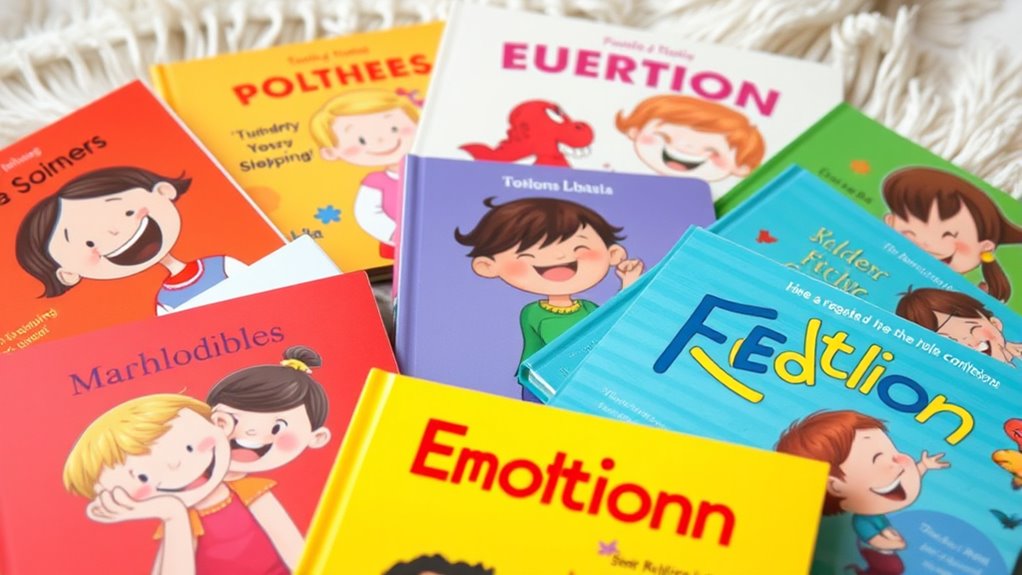
When choosing emotion books for toddlers, I always consider whether they suit the child’s age and developmental level. I also look for colorful, engaging visuals and a variety of emotional themes to keep their interest. Additionally, I think about simple language and diverse characters to help children relate and learn about different feelings.
Age Appropriateness
Choosing emotion books that are appropriate for toddlers means paying close attention to their developmental stage. I look for books with simple language and clear visual cues that match their limited attention spans and cognitive abilities. It’s important to focus on basic emotions like happiness, sadness, anger, and fear, which are most relevant to their everyday experiences. I also consider the themes to ensure they are age-appropriate, avoiding complex or abstract ideas that might confuse or overwhelm them. Durable, colorful illustrations help keep their interest and make the learning process engaging. Additionally, books with interactive elements or practical strategies support active participation and emotional regulation. By selecting books suited to their developmental level, I help foster understanding and emotional growth in a gentle, accessible way.
Visual Engagement
Bright, colorful illustrations are key to capturing toddlers’ attention and making emotional concepts easier for them to understand. Large, clear images help little ones identify facial expressions and body language linked to feelings, making the emotions more relatable. Engaging visuals that include diverse characters promote inclusivity, helping children see themselves reflected in stories. Interactive elements like pop-ups or textured features can boost sensory engagement and reinforce learning about feelings. Consistent visual cues, such as specific colors for different emotions, support toddlers in connecting feelings with their visual representations. When choosing emotion books, look for illustrations that are vibrant, easy to interpret, and inclusive. These visual strategies make emotional learning more engaging and accessible, helping toddlers grasp complex feelings more naturally.
Emotional Range
A wide emotional range in books is essential because it exposes toddlers to feelings beyond just happiness, helping them recognize and understand a spectrum of emotions like sadness, anger, fear, and surprise. By including diverse emotions, these books promote emotional literacy, allowing children to identify and label their feelings accurately. They also foster empathy and self-awareness by showing various ways emotions are expressed and experienced. Covering both positive and challenging feelings encourages kids to accept and normalize their emotions, reducing shame or confusion. Additionally, an extensive emotional spectrum helps caregivers address specific feelings children may be experiencing, enabling meaningful conversations and coping strategies. Overall, exposing toddlers to a broad range of emotions builds resilience, adaptability, and emotional intelligence from an early age.
Language Simplicity
When selecting emotion books for toddlers, it’s important to prioritize simple, age-appropriate language that young children can easily understand and repeat. Clear, concise sentences help little ones grasp emotional concepts without feeling overwhelmed or confused. Repetitive phrasing and familiar words reinforce learning and make it easier for toddlers to remember emotional vocabulary. Avoiding complex vocabulary or abstract descriptions keeps the book accessible and engaging for early learners. The language should also promote positive, supportive messages that encourage children to recognize and express their feelings comfortably. By focusing on straightforward, easy-to-understand language, we create a nurturing environment where toddlers feel confident exploring their emotions and building emotional intelligence through reading.
Cultural Diversity
Choosing emotion books for toddlers also means paying attention to cultural diversity. Including characters from various backgrounds helps children see themselves and others positively, fostering inclusivity and empathy. Books that showcase different cultural expressions, traditions, and languages deepen a child’s understanding of feelings across communities. These stories can challenge stereotypes and encourage respect for differences, supporting social-emotional development. When toddlers are exposed to multicultural content, they learn that emotional reactions and coping methods vary worldwide, enhancing their emotional literacy and adaptability. Research shows that embracing diverse cultural stories broadens young children’s perspectives and promotes acceptance of different emotional norms. By choosing books with cultural diversity, we help nurture open-minded, empathetic, and emotionally competent individuals.
Durability & Quality
Durability and quality are essential factors to contemplate when selecting emotion books for toddlers, as young children tend to handle books roughly during play. Look for books made from sturdy materials like thick cardboard or laminated pages that can withstand frequent handling and spills. Reinforced binding and rounded corners help prevent tearing and fraying, extending the book’s lifespan. Water-resistant or laminated pages are ideal for enduring drool, snacks, or cleaning. A durable cover that resists wear and tear ensures the book maintains its visual appeal over time. Choosing well-constructed books with tear-proof binding and sturdy materials guarantees they stay intact through energetic use, making them a worthwhile investment that can be enjoyed repeatedly without falling apart.
Interactive Elements
Interactive elements like flaps, textures, and mirrors can particularly boost a toddler’s engagement with emotion books. These features invite hands-on exploration, helping children connect physically with feelings and concepts. Touch-and-feel textures or pop-up visuals stimulate sensory learning, making emotions more memorable and relatable. Incorporating interactive components also encourages active participation, which can enhance emotional recognition and communication skills. When children interact directly with the book, it opens opportunities for caregivers to engage in meaningful conversations about feelings. Additionally, such features can motivate reluctant readers by making emotional learning playful and inviting. Overall, choosing books with engaging interactive elements not only captures a toddler’s attention but also deepens their understanding of emotions through sensory and shared experiences.
Practical Application
When selecting emotion books for toddlers, it’s important to look for titles that incorporate practical techniques like breathing exercises or visual cues, which can help children apply emotional regulation skills in real-life situations. These tools make it easier for toddlers to connect what they learn from the book to their own experiences. Choose books with interactive elements, such as flaps or prompts, that encourage kids to recognize and express feelings actively. Opt for titles with simple, relatable language and scenarios, so children can easily understand and practice coping strategies. Prioritize books that promote positive behaviors like kindness and self-control, which children can imitate daily. Additionally, seek resources that guide caregivers on modeling emotional skills, ensuring consistent support and reinforcement at home.
Frequently Asked Questions
How Do I Choose Age-Appropriate Emotion Books for My Toddler?
When choosing books for my toddler, I focus on age-appropriate content that’s simple and visual. I look for colorful pictures, clear language, and relatable emotions. I avoid complex stories or abstract concepts. I also check the recommended age range on the packaging. Engaging, sturdy books with interactive elements keep my toddler interested and help them understand feelings in a fun, accessible way.
What Are Signs My Toddler Understands Emotional Concepts?
You might worry that your toddler isn’t grasping emotional concepts, but look for signs like them naming feelings, comforting others, or choosing books about emotions. I’ve found that when they start to recognize and talk about feelings, it shows real understanding. Don’t stress if progress seems slow; emotional development varies. Keep engaging with age-appropriate stories, and you’ll see their awareness grow naturally over time.
How Can I Make Reading Emotion Books Interactive?
To make reading emotion books interactive, I encourage you to ask your toddler questions about the story and their own feelings. Pause often to discuss the characters’ emotions and relate them to your child’s experiences. Use expressive voices and gestures to bring the story to life, and invite your toddler to mimic feelings or act out scenes. This engagement helps deepen their understanding and makes reading a fun, emotional learning experience.
Are There Cultural Differences in Emotion Book Content?
Imagine a rainbow—its colors vary across cultures, yet it’s universally beautiful. That’s how emotion book content can differ culturally, reflecting unique expressions and values. I’ve noticed some stories highlight community and family roles more in certain cultures, shaping how feelings are understood. While core emotions like happiness or sadness are universal, the way we express and interpret them can vary, making diverse stories essential for a well-rounded emotional understanding.
How Often Should I Read Emotion Books With My Toddler?
I believe reading emotion books with your toddler regularly is key. I try to do it a few times a week, making it a cozy routine. Consistent reading helps my child recognize feelings and build emotional skills. I also pay attention to their mood, reading more when they seem interested or need extra support. This steady exposure makes understanding emotions natural and less overwhelming for them.
Conclusion
Choosing the right emotion books can truly make a difference. I remember a toddler who struggled with anger until he connected with “Hands Are Not for Hitting.” After reading it together, he started expressing his feelings calmly. These books aren’t just stories—they’re tools to help your little one understand and manage their emotions. Trust me, a small investment in these books can lead to big emotional growth for your child.



